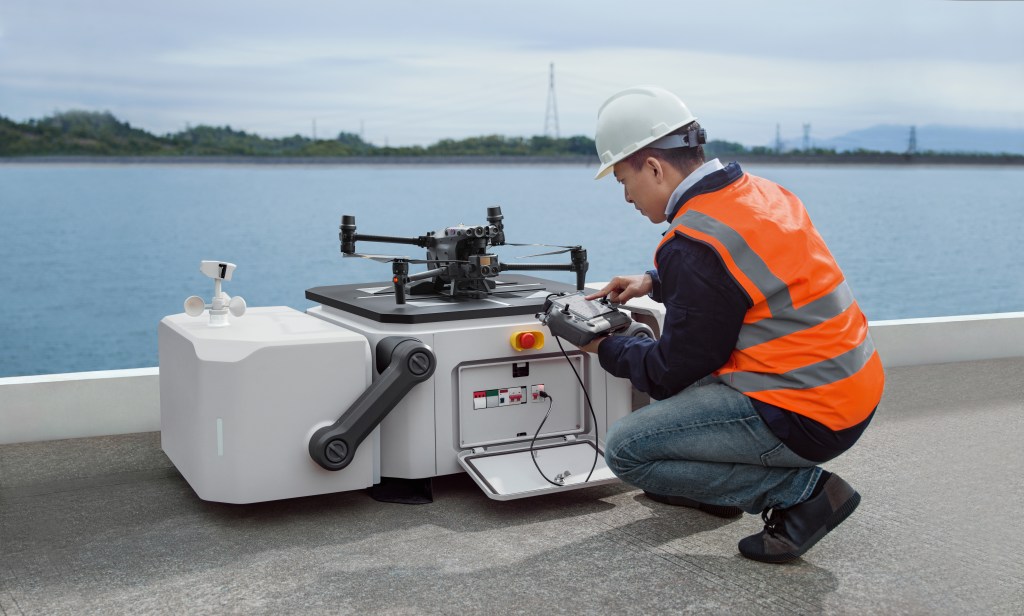
There has never been much lacking in DJI’s wide range of UAV products – apart from a conspicuously absent drone-in-a-box devise, that is. This morning that hole was filled with the company’s introduction of the DJI Dock as an accompanying product to its newly unveiled Matrice 30 enterprise craft.
The DJI Dock is designed to fully automate flights of the company’s flagship Matrice 30 enterprise drone, which it rolled out alongside the new FlightHub 2 fleet management software, RC Plus remote controller, and Zenmuse H20N hybrid sensor. Compatible craft in the Matrice 30 family can now be programmed to take off, fly, and execute tasks during missions, then return, land, and start recharging automatically with maximum safety and efficiently.
Creation of a docking system was key to DJI offering enterprise clients a complete range of in-house products enabling fully automated inspections, surveillance, mapping, engineering supervision, and other missions that may require longer-distance beyond visual line of sight flights (BVLOS). Up until now, DJI consumer and enterprise users wanting docking capabilities had to buy craft-compatible products made by Airobotics, Percepto, Hextronics, Ideployer, and others.
No longer, however. After setup, a recharged M30 drone can take off from its DJI Dock for automatic flights programmed through FlightHub 2, and perform its work within a seven-kilometer radius. Once it returns and touches down, the dock’s fast charging and battery cooling system will allow the UAV to again take to the air in just 25 minutes.
In addition to opening up automated BVLOS enterprise capabilities and fast turnaround times, the DJI Dock is also designed for simplicity of use. Configuration can be carried out using the DJI RC Plus, which oversees linked control of the Dock, M30, drone, mission details and scheduling, as well management of data collected.

DJI says installation is a one-step procedure, with the dock’s integrated design reducing deployment complexities (apart lugging from its 90 kg weight around). Once in place, all the device needs to perform is a power supply and internet connectivity. The DJI Dock features built-in antennas, a weather station, ultra-wide-angle surveillance cameras, and a D-RTK base station.
The unit’s modular design allows continuous operation both day and night, and boasts a durability that will withstand most weather conditions. The DJI Dock is rated at IP55, meaning it’s safe from dust infiltration, and the core internal components are IP67 – that is, waterproof even when the doors are open under rainy skies. Its interior is climate controlled in order to return the drone’s batteries to optimal temperatures for safe charging, and the dock maintains stable internal conditions amid external temperatures ranging from -35 to 50 degrees Celsius.
The device’s connectivity can be expanded using its built-in external 4G dongle port. In case of power outages, meanwhile, an internal battery will kick in and keep the DJI Dock operational to insure its M30 bird returns and lands safely from its mission.
In presenting the new unit, DJI said its M30 dock is currently being tested by selected users and should be available for purchase beginning in the last quarter of 2022.

Arrival of the DJI Dock was a long time coming, with the company’s first patent application for a drone-in-a-box device dating back to 2017, and that copyright being granted just last year. In August, drone sector sleuth OsitaLV tweeted schematic drawings of the device. He was also a main actor in the recent spate of leaks about a rumored M30, as well as what he said would be an accompanying dock – rumors confirmed today by DJI itself.
FTC: We use income earning auto affiliate links. More.




Comments